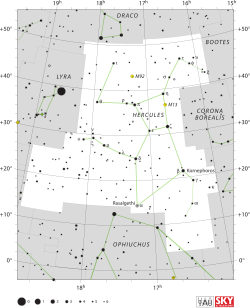Chi Herculis – Wikipedia
| Chi Herculis (χ) | |
 | |
| Observationsdata Epok: J2000.0 | |
|---|---|
| Stjärnbild | Herkules |
| Rektascension | 15t 52m 40,54141s[1] |
| Deklination | +42° 27′ 05,4664″[1] |
| Skenbar magnitud () | 4,59[2] |
| Stjärntyp | |
| Spektraltyp | G0V Fe-0,8 CH-0,5[3] |
| U–B | +0,01[2] |
| B–V | +0,57[2] |
| Astrometri | |
| Radialhastighet () | -56,09 ± 0,10 [4] km/s |
| Egenrörelse (µ) | RA: +438,90[1] mas/år Dek.: +629,70[1] mas/år |
| Avstånd | 51,8 ± 0,2 lå (15,89 ± 0,05 pc) |
| Detaljer | |
| Massa | 1,054 +0,015 -0,054[5] M☉ |
| Radie | 1,71 +0,04 -0,05[5] R☉ |
| Temperatur | 5 837[3] K |
| Metallicitet | -0,45[3] |
| Vinkelhastighet | 2,4[6] |
| Ålder | 7,4[7] miljarder år |
| Andra beteckningar | |
| 1 Herculis, BD + 42° 2648, FK5, GJ 602, HD 142373, HIP 77760, HR 5914, SAO 45772, WDS J16254 + 1402AB.[8] | |
Chi Herculis (χ Herculis, förkortat Chi Her, χ Her) som är stjärnans Bayerbeteckning, är en solliknande stjärna[9] belägen i nordvästra delen av stjärnbilden Herkules. Den har en skenbar magnitud på 4,59[2] och är synlig för blotta ögat. Baserat på en årlig parallaxförskjutning på 62,92 mas, sett från jorden, beräknas den befinna sig på ett avstånd av ca 52 ljusår (15,9 parsek) från solen. Den har en relativt hög egenrörelse som visar en tvärgående rörelse på 0,769 bågsekunder per år.[10]
Egenskaper
[redigera | redigera wikitext]Chi Herculis är en misstänkt dubbelstjärna där den primära komponenten är en huvudseriestjärna av typ G av spektralklass G0V Fe-0,8 CH-0,5,[3] vilken anger stora brister på järn- och kolvätemolekyler. Den ytmagnetiska aktiviteten för stjärnan är tydligt lägre än den typiska nivån för normala stjärnor, och den anses därför vara en bra kandidat för att vara i en Maunder-minimifas.[11] Stjärnan har en massa något större än solens och en radie som är 1,7 gånger solens radie.[5] Den har en effektiv temperatur på 5 837 K[3], även den i paritet med solens.
En följeslagare med en noterad cirkulär omloppsbana med en period på 51,3 dygn har publicerats.[12] Andra källor bekräftar dock inte detta och därför är binariteten fortfarande ifrågasatt.[13] Stjärnan har undersökts med avseende på närvaro av överskott på infrarött ljus som kan indikera en omkretsande stoftskiva, men inget sådant hittades.[9]
Källor
[redigera | redigera wikitext]- Den här artikeln är helt eller delvis baserad på material från engelskspråkiga Wikipedia, tidigare version.
Referenser
[redigera | redigera wikitext]- ^ [a b c d] van Leeuwen, F. (2007), "Validation of the new Hipparcos reduction", Astronomy and Astrophysics, 474 (2): 653–664, Bibcode:2007A&A...474..653V, arXiv:0708.1752 Freely accessible, doi:10.1051/0004-6361:20078357.
- ^ [a b c d] Mermilliod, J.-C. (1986), "Compilation of Eggen's UBV data, transformed to UBV (unpublished)", Catalogue of Eggen's UBV data, SIMBAD, Bibcode:1986EgUBV........0M.
- ^ [a b c d e] Gray, R. O.; et al. (July 2006), "Contributions to the Nearby Stars (NStars) Project: spectroscopy of stars earlier than M0 within 40 pc-The Southern Sample", The Astronomical Journal, 132 (1): 161–170, Bibcode:2006AJ....132..161G, arXiv:astro-ph/0603770 Freely accessible, doi:10.1086/504637.
- ^ de Bruijne, J. H. J.; Eilers, A.-C. (October 2012), "Radial velocities for the HIPPARCOS-Gaia Hundred-Thousand-Proper-Motion project", Astronomy & Astrophysics, 546: 14, Bibcode:2012A&A...546A..61D, arXiv:1208.3048 Freely accessible, doi:10.1051/0004-6361/201219219, A61.
- ^ [a b c] Takeda, Genya; et al. (February 2007), "Structure and Evolution of Nearby Stars with Planets. II. Physical Properties of ~1000 Cool Stars from the SPOCS Catalog", The Astrophysical Journal Supplement Series, 168 (2): 297–318, Bibcode:2007ApJS..168..297T, arXiv:astro-ph/0607235 Freely accessible, doi:10.1086/509763.
- ^ Fekel, F. C. (May 1997), "Rotational Velocities of Late-Type Stars", Publications of the Astronomical Society of the Pacific, 109: 514−523, Bibcode:1997PASP..109..514F, doi:10.1086/133908.
- ^ Casagrande, L.; et al. (2011), "New constraints on the chemical evolution of the solar neighbourhood and Galactic disc(s). Improved astrophysical parameters for the Geneva-Copenhagen Survey", Astronomy & Astrophysics, 530 (A138): 21, Bibcode:2011A&A...530A.138C, arXiv:1103.4651 Freely accessible, doi:10.1051/0004-6361/201016276.
- ^ "chi Her -- High proper-motion Star", SIMBAD Astronomical Database, Centre de Données astronomiques de Strasbourg, hämtad 2017-04-05.
- ^ [a b] Maldonado, J.; et al. (May 2012), "Metallicity of solar-type stars with debris discs and planets", Astronomy and Astrophysics, 541, Bibcode:2012A&A...541A..40M, arXiv:1202.5884 Freely accessible, doi:10.1051/0004-6361/201218800.
- ^ Lépine, Sébastien; Shara, Michael M. (March 2005), "A Catalog of Northern Stars with Annual Proper Motions Larger than 0.15" (LSPM-NORTH Catalog)", The Astronomical Journal, 129 (3): 1483–1522, Bibcode:2005AJ....129.1483L, arXiv:astro-ph/0412070 Freely accessible, doi:10.1086/427854.
- ^ Hempelmann, A.; et al. (February 1996), "Coronal X-ray emission of late-type MS stars in relation to chromospheric activity and magnetic cycles", International Conference on X-ray Astronomy and Astrophysics: Röntgenstrahlung from the Universe, pp. 45−46, Bibcode:1996rftu.proc...45H.
- ^ Hartkopf, W. I.; et al. (2006), Sixth Catalog of Orbits of Visual Binary Stars, hämtad 2017-04-03
- ^ Rodriguez, David R.; et al. (May 2015), "Stellar multiplicity and debris discs: an unbiased sample", Monthly Notices of the Royal Astronomical Society, 449 (3): 3160–3170, Bibcode:2015MNRAS.449.3160R, arXiv:1503.01320 Freely accessible, doi:10.1093/mnras/stv483.


 French
French Deutsch
Deutsch

